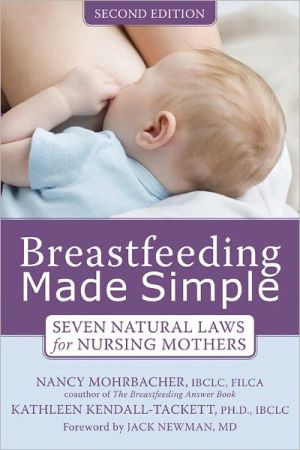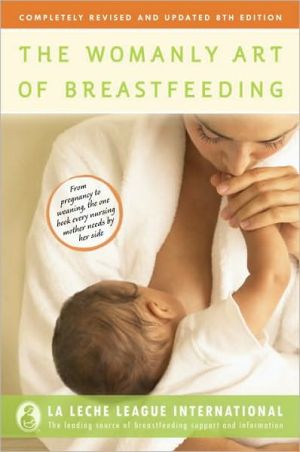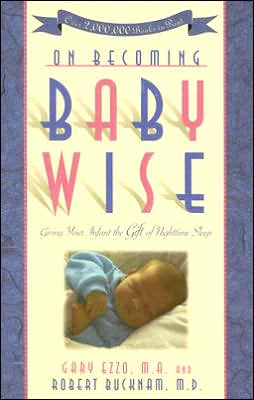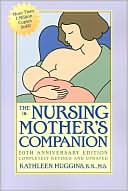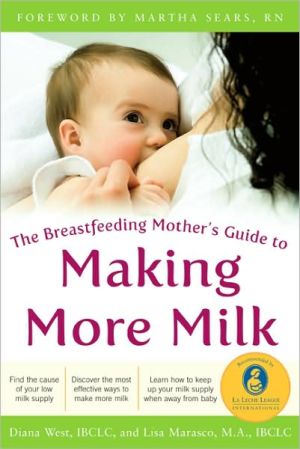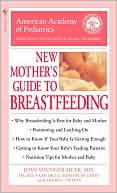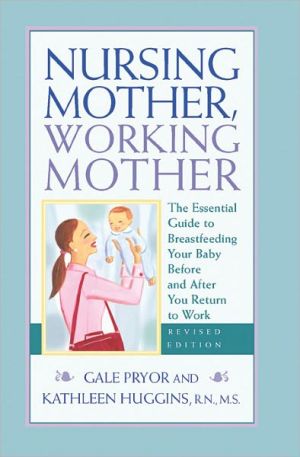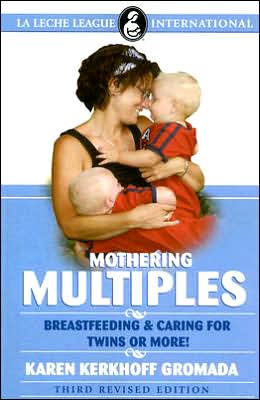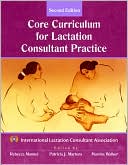Breastfeeding Made Simple
The Definitive Guide to Breastfeeding Your Baby\ Breastfeeding may be natural, but it may also be more challenging than you expect. Some mothers encounter doubts and difficulties, from struggling with the first few feedings to finding a gentle and loving way to comfortably wean from the breast.\ This second edition of Breastfeeding Made Simple is an essential guide to breastfeeding that every new and expectant mom should own-a comprehensive resource that takes the mystery out of basic...
Search in google:
The Definitive Guide to Breastfeeding Your Baby Breastfeeding may be natural, but it may also be more challenging than you expect. Some mothers encounter doubts and difficulties, from struggling with the first few feedings to finding a gentle and loving way to comfortably wean from the breast. This second edition of Breastfeeding Made Simple is an essential guide to breastfeeding that every new and expectant mom should own-a comprehensive resource that takes the mystery out of basic breastfeeding dynamics. Understanding the seven natural laws of breastfeeding will help you avoid and overcome challenges such as low milk production, breast refusal, weaning difficulties, and every other obstacle that can keep you from enjoying breastfeeding your baby. Breastfeeding Made Simple will help you to: • Find comfortable, relaxing breastfeeding positions • Establish ample milk production and a satisfying breastfeeding rhythm with your baby • Overcome discomfort and mastitis • Use a breast pump to express and store milk • Easily transition to solid foods
Congratulations! You are about to take part in one of life’s great miracles—breastfeeding your baby. For the vast majority of women, breastfeeding is entirely possible. But sometimes women have a hard time. The good news is that breastfeeding can be simple, especially if you know the tricks. And we’re here to share them with you.\ Allow us to introduce ourselves. We are Nancy and Kathy, and between us, we have more than fifty years of experience working with breastfeeding mothers.\ Nancy breastfed her own three sons, Carl, Peter, and Ben, who are now grown, and she has been working with breastfeeding families since 1982. As a board-certified lactation consultant since 1991, Nancy founded and ran a large lactation private practice in the Chicago area for ten years. She is the author of Breastfeeding Answers Made Simple: A Guide for Helping Mothers (2010), a book for lactation professionals, and also the coauthor of the popular Breastfeeding Answer Book (2003), a research-based counseling guide used by health professionals internationally. In 2008 the International Lactation Consultant Association (ILCA) officially recognized Nancy’s lifetime achievements in the field of breastfeeding—as one of the first group of sixteen—by awarding her the designation FILCA, which stands for Fellow of the International Lactation Consultant Association. Nancy now works as a lactation consultant at Ameda Breastfeeding Products, manufacturer of the Ameda breast pumps, where she talks daily to breastfeeding mothers by phone and provides breastfeeding education to health professionals. She also leads a monthly breastfeeding group for families in the Chicago area. She lectures to health care providers around the world.\ Kathy breastfed her two sons, Ken and Chris, and is a health psychologist, board-certified lactation consultant, and La Leche League leader. She has been working with breastfeeding families since 1994 and is the former chair of the New Hampshire Breastfeeding Task Force. She now lives in the Texas Panhandle, where she is a clinical associate professor of pediatrics at Texas Tech University School of Medicine in Amarillo and, among her other responsibilities, really enjoys teaching pediatric residents about breastfeeding. She also works with mothers by phone and online, particularly around mental health issues and breastfeeding. Kathy is a Fellow of the American Psychological Association in both health and trauma psychology. She also works as an acquisitions and development editor for Hale Publishing, developing a series of books for both mothers and professionals on breastfeeding.\ Kathy’s research focuses on the mind-body connection in health, and encompasses such broad-ranging topics as trauma and health, depression in new mothers, and breastfeeding. She has authored or edited twenty books, and authored more than 250 articles, book chapters, and other pieces of work on a wide range of topics in women’s health. Some of her most recent books include Depression in New Mothers, 2nd ed. (Routledge, 2010); Non-pharmacologic Treatments for Depression in New Mothers (Hale Publishing, 2008); and The Psychoneuroimmunology of Chronic Disease (American Psychological Association, 2009).Kathy is currently analyzing data from her Survey of Mothers’ Sleep and Fatigue—an international study of sleep in mothers of infants. She speaks to audiences of health care providers on these issues around the world.\ In this book, we will share with you the simple dynamics—or "natural laws"—of breastfeeding that all good lactation consultants use to help mothers. If you read this book during pregnancy, you can use these natural laws to avoid breastfeeding problems. If you read this book after your baby’s birth, you can use these laws to make breastfeeding easier, solve problems, and help meet your breastfeeding goals.\ These natural laws are the "secrets" nobody told you about breastfeeding. After generations of bottlefeeding, we are now relearning what women used to know about nursing their babies. If you never had the opportunity to see women breastfeed while you were growing up, learning these natural laws is a must. In a world of conflicting information, you can use them to distinguish good breastfeeding advice from bad.\ Breastfeeding: The Biological Norm for Mothers and Babies\ As we wrote the first edition of this book, a national advertising campaign promoting breastfeeding was launched in the United States. The primary focus of the Ad Council (the company that made the ads) was to promote exclusive breastfeeding for six months. The slogan of the Ad Council’s breastfeeding campaign is "Babies were born to be breastfed," meaning that breastfeeding is the biological norm for mothers and babies. Let’s take a look at why the Ad Council chose breastfeeding as an important public-health initiative.\ Health Outcomes and Human Milk\ In 2009, an article in the April issue of the Atlantic described "The Case Against Breastfeeding" (Rosin 2009). And it made headlines around the world. The author, Hanna Rosin, contended that the public had been deceived to believe that mother’s milk made huge differences in health—and that it simply wasn’t true. In fact, she claimed that breastfeeding was just another way to subjugate women. And why do it at all if it was just going to cause you a lot of stress?\ We must respectfully disagree.\ At this point, the research studies comparing breastfeeding with man-made substitutes number in the thousands, and the findings show striking differences. Don’t take our word for it. We invite you to examine the evidence for yourself and have made some of the major research reviews available on our website (breastfeedingmadesimple.com). Researchers have found that during the first year of life, babies fed nonhuman milks have a higher incidence of these health problems:\ \ respiratory disease, including pneumonia and bronchitis\ diarrhea and other digestive illnesses\ ear infections (up to four times more than babies fed human milk)\ urinary tract infections\ meningitis\ sudden infant death syndrome (SIDS) (Ip et al. 2009)\ \ Babies deprived of human milk’s living antibodies are sick more often, have more severe illnesses, and are hospitalized more often and for a longer time (Cunningham, Jelliffe, and Jelliffe 1991). Examining the research worldwide, a 2003 article in the Lancet concluded that exclusive breastfeeding for six months by 90 percent of mothers could prevent 13 percent of child deaths—or save 1.3 million children annually (Jones et al. 2003). These findings are not confined to the developing world. A 2004 article in Pediatrics reported that 21 percent of U.S. infant deaths between one month and one year of age could be prevented if all U.S. babies did any amount of breastfeeding (Chen and Rogan 2004). Stated another way, what this really means is that infant formula increases U.S. infant deaths during the first year of life by 27 percent. Even more striking, during a baby’s first three months, this paper found that exclusive formula feeding increases infant mortality by 61 percent. A 2010 article estimated that each year, exclusive breastfeeding for six months by 90 percent of U.S. mothers could prevent 911 infant deaths and save the U.S. health care system US$13 billion (Bartick and Reinhold 2010).\ But the negative health outcomes associated with nonhuman milks are not limited to infancy. Adults who were formula fed as infants have a higher incidence of these health problems:\ \ allergy\ asthma\ Crohn’s disease and other inflammatory bowel diseases\ diabetes (both type 1 and type 2)\ Hodgkin’s disease\ childhood leukemia\ celiac disease\ childhood cancers\ breast cancer\ obesity (AAP 2005b; Ip et al. 2007)\ \ The list of health problems associated with formula use continues to grow. In fact, the more we learn, the clearer it becomes that for a baby’s immune system to be fully activated after birth, human milk’s living antibodies are needed for at least the first twelve months of life.\ More Than Food\ Your milk is good food for your baby, of course, but it is so much more. At birth, your baby’s body expects to receive the unique living components that are in your milk. If your baby is fed nonhuman milks, he will be missing many ingredients essential for normal body function. There are many ways these essential elements affect your baby. But for now we’ll take a close look at the impact of human milk on just three aspects of your baby’s body: immune function, digestion, and brain development.\ Normal Immune Function\ Let’s begin with the role of your early milk, known as colostrum, which is in your breasts during pregnancy and after birth. The World Health Organization calls colostrum "baby’s first immunization" because of the many immune factors it contains (WHO 2001). These are especially important to your baby during her first weeks outside the protection of your womb, when she is most vulnerable to infection and illness.\ Dairy farmers know that the newborn calf deprived of colostrum is a dead calf, because calves are born with little to no inborn protection from illness. What they need in order to survive comes from their mother’s colostrum. To protect their newborn calves, farmers move heaven and earth to make sure the calves get colostrum. We humans receive enough protection from illness and infection before birth to survive without colostrum, as many of us who did not receive colostrum as babies can attest. But although we can live without it, quality of life suffers. A newborn who does not receive her mother’s colostrum is a newborn at risk.\ Immune factors (macrophages, leukocytes, secretory IgA, and more) in both your colostrum and your mature milk bind microbes and prevent them from entering your baby’s delicate tissues. They kill microorganisms and block inflammation. They also promote normal growth of your baby’s thymus, an organ devoted solely to developing normal immune function. The thymus in a baby who is fed nonhuman milks is subnormal in size, on average only about half the size of the thymus of an exclusively breastfed baby (Hanson 2004). The immune factors of human milk do not provide breastfed babies with an "extra" boost to their immune system. Human milk is the biological norm—what your baby’s body needs and expects at birth. The sad reality is that babies who don’t breastfeed suffer from immune-system deficiencies (Labbok, Clark, and Goldman 2004).\ Human milk is even more important to at-risk babies. Premature babies who are formula fed take longer to tolerate oral feedings and are six to twenty times more likely to develop necrotizing enterocolitis, a potentially fatal bowel disease (AAP 2005b). Babies born with PKU, a metabolic disorder, lose an average of fourteen IQ points if they are fed formula before their disorder is discovered (Riva et al. 1996). Babies born with cystic fibrosis tend to develop symptoms earlier, grow more slowly, and develop more respiratory infections if they are fed any formula at all (Holliday et al. 1991). Babies with cardiac problems have longer hospital stays and have more problems gaining weight if they miss out on mother’s milk (Combs and Marino 1993). Bottom line, for a baby’s immune system to function normally, he needs mother’s milk.\ Normal Digestive Health\ Human milk also plays a unique role in digestive health. A newborn’s digestive system is sterile and immature at birth and needs help in creating the right environment for digestion and normal development. Right from the start, colostrum creates this normal environment in your baby’s digestive system by encouraging the growth of the good bacteria (bifidus flora). This good bacteria is responsible for the mild odor of a breastfed baby’s stools. A normal gut environment discourages the growth of harmful bacteria and helps a baby’s immune system develop properly. If even a small amount of formula or other foods are given, this changes the gut flora so that within twenty-four hours, it resembles that of an adult, which is more vulnerable to harmful bacteria and infection. This is one reason why the Ad Council campaign emphasized exclusive breastfeeding. Once the baby is back to an exclusive human milk diet, it takes two to four weeks for the gut flora to return to normal.\ One of the most important functions of colostrum is to seal your newborn’s gut to prevent harmful bacteria from sticking to it and penetrating. The junctions between the cells of your baby’s intestinal tract are much more open at birth than they will be even several weeks later. While these junctions are open, your baby is vulnerable to allergy triggers (antigens) passing through the gut membranes and causing sensitization. Introducing foreign proteins too early, such as those found in cow’s milk and soy-based formulas, can lead to allergy or food intolerance during the first year (Høst 1991).\ There are other properties of your milk that are important to your baby’s digestive health. For example, growth factors in your milk help your baby’s gut to mature more quickly, help the intestinal mucous lining to grow and develop, and strengthen your baby’s intestinal barrier. Because a newborn makes few digestive enzymes, human milk provides the bulk of those needed (amylase and bile salts). There are also at least two antioxidants in breast milk that discourage inflammation (Hanson 2004). All of these components help your baby develop a normal digestive system. Anything less can lead to digestive problems.\ Your Baby’s Brain\ Breastfeeding is also good for your baby’s brain development. One large study of 14,660 babies in the United Kingdom found that babies who were not breastfed were 30 percent more likely to have gross motor delays at nine months than babies who received even some mother’s milk and 40 percent more likely to be developmentally delayed than babies exclusively breastfed for at least four months (Sacker, Quigley, and Kelly 2006). A major landmark study in Belarus of 17,046 children found that those children who were breastfed as infants had significantly higher scores on the Wechsler Abbreviated Scales of Intelligence and higher teacher ratings in reading, writing, and math at age six and a half than their counterparts who were not breastfed (Kramer et al. 2008).\ Why would this be? One possibility is that your milk has the right mix of fatty acids that are important for your baby’s developing brain—especially the omega-3 fatty acid DHA. Yes, this has recently been added to formula. But the problem is that researchers are not entirely sure about the optimal amount, something breastfeeding mothers don’t need to worry about. In addition, breastfeeding involves you. It’s not just a matter of delivering a better product in an attractive package. As you interact with your baby, and respond to her needs, you are giving her just what she needs for her brain to thrive.\ Accept No Substitutes\ Every few years, the formula companies come up with another "new" ingredient to make formula "more like mother’s milk." But what they don’t tell you is that vital, living parts of human milk could never survive the canning process, so they will always be missing from formula. And even with the latest new ingredient, there are hundreds of other ingredients in human milk still absent from formula. Some of these ingredients science hasn’t even identified yet! Our lack of knowledge is reason enough to avoid man-made substitutes unless absolutely necessary. Even without knowing all the components of human milk, the breastfed baby wins. Breastfeeding is the original no-brainer.\ Health Outcomes for You\ Our focus up until now has been on your baby. But breastfeeding is also the biological norm for you, and there are negative health outcomes for mothers who don’t breastfeed. Moms who don’t breastfeed have greater incidence of postpartum hemorrhage, osteoporosis, cardiovascular disease, metabolic syndrome (the precursor to type 2 diabetes), and cancers of the breast, uterus, and ovaries (AAP 2005b; Ram et al. 2008; Schwarz et al. 2009). After birth, mothers who do not breastfeed experience a rapid shift in hormonal levels. Breastfeeding provides a gradual postpartum hormonal shift that can make your transition to motherhood smoother and easier. In chapter 2, we discuss how the hormones of breastfeeding make new motherhood less stressful and bring you and your baby closer. Anything less than exclusive breastfeeding also means a significantly faster return to fertility after birth (AAP 2005b).\ Breastfeeding can even impact your financial health. Formula costs a minimum of US$1,200 during your baby’s first year. And depending on the type you use and what your baby can tolerate, it could cost you as much as two to three times that amount. This estimate does not include the cost of feeding equipment and extra health care costs, as babies on nonhuman milk tend to be sick more often and more severely (Cunningham, Jelliffe, and Jelliffe 1991). In 1999 dollars, on average, formula-fed babies are estimated to incur US$300–$400 in extra health care costs during their first year of life (Ball and Wright 1999). If you work outside the home, using formula can mean more days off from work to care for a sick child. Any way you look at it, not breastfeeding is expensive.\ We’re hoping you find this information motivating. Breastfeeding is much more than a lifestyle choice or a nice "touchy-feely" option. It is well worth it for both you and your baby, even if it’s tough at first. When we hear the expression "the best things in life are free," one of the first things that comes to mind for us is breastfeeding.\ How to Use This Book\ This book is organized in two parts. Part 1 explains each of the seven natural laws of breastfeeding and how they work. We will walk with you down the road of normal breastfeeding. Also included in this journey is an explanation of what can happen when the laws are not followed. In chapter 8, we’ll also discuss the forces that interfere with the laws and what you can do to counter them.\ Part 2 helps you apply the laws to common breastfeeding challenges. It also includes helpful hints on how to fit breastfeeding into your daily life as well as what to do when normal breastfeeding isn’t possible. We include specific information on how to find personal help, as a book can never be a substitute for the one-on-one help of a lactation professional. We also have additional information and resources available on our website (breastfeedingmadesimple.com). We will refer you to our site throughout the book. This new edition also includes an index to help you locate more easily the information you need about a particular concern.\ Regarding our choice of words, we recognize that babies come in two sexes. To acknowledge this while avoiding awkward constructions like "he/she" throughout, we have alternately referred to babies as "he" or "she" in every other chapter.\ Finally, our main purpose for writing this book is to help you meet your breastfeeding goals. To do this, we try to strip away the confusion that often accompanies breastfeeding. By focusing on breastfeeding’s most basic principles (rather than a complicated list of "rules"), we hope you will find it easier to relax and enjoy your baby. We want your breastfeeding experience to be as simple and joyful as it was meant to be.
Foreword vii\ Introduction 1\ Breastfeeding: The Biological Norm for Mothers and Babies\ How to Use This Book\ Part I The Laws\ Chapter 1 Your Baby's Birth 13\ Law 1 Babies and Mothers Are Hardwired to Breastfeed\ Your Baby's Hardwiring\ Are Mothers Hardwired, Too"\ When the System Breaks Down\ Summary\ Chapter 2 The Power of Touch: Why Holding Your Baby Matters 33\ Law 2 Mother's Body Is Baby's Natural Habitat\ The Habitat of the Human Newborn\ When the System Breaks Down\ Summary\ Chapter 3 Getting Comfortable: The Heart of Successful Breastfeeding 49\ Law 3 Better Feel and Flow Happen in the Comfort Zone\ What Every Mother Needs to Know About Comfortable Breastfeeding\ When the System Breaks Down\ Summary\ Chapter 4 The First Week of Breastfeeding 77\ Law 4 More Breastfeeding at First Means More Milk Later\ A Baby's Transition after Birth\ Breastfeeding Basics\ How to Know When Breastfeeding Is Going Well\ When the System Breaks Down\ Summary\ Chapter 5 How Your Baby Sets Your Milk Production 103\ Law 5 Every Breastfeeding Couple Has Its Own Rhythm\ The Adjustment Period\ Breastfeeding Norms\ When the System Breaks Down\ Summary\ Chapter 6 Meeting Your Long-Term Breastfeeding Goals 131\ Law 6 More Milk Out Equals More Milk Made\ The Reward Period\ How Milk Production Works\ What Is Full Milk Production"\ What Everyone Thinks Affects Milk Production (But Doesn't)\ Meeting Your Long-Term Goals\ Starting Solid Foods\ When the System Breaks Down\ Summary\ Chapter 7 Weaning Comfortably and Happily 155\ Law 7 Children Wean Naturally\ A Weaning Overview\ Weaning Basics\ The Role of Solid Foods\ When the System Breaks Down\ Summary\ Chapter 8 What Interferes with the Laws 185\ The Role of History and Culture\ Summary\ Part II Applying the Laws\ Chapter 9 Daily Life with Your Breastfeeding Baby 207\ Reentering the World with Your Breastfeeding Baby\ Away from Your Baby\ Lifestyle Issues\ Expressing and Storing Milk\ Medications and Contraception\ Chapter 10 Common Breastfeeding Challenges 239\ Mother-Related Challenges\ Baby-Related Challenges\ Chapter 11 Special Situations: Physical or Health Issues 263\ Special Situations: Mother\ Special Situations: Baby\ When You Need to Temporarily Stop Breastfeeding\ Alternatives to Feeding at the Breast\ Pumping to Establish Full Milk Production\ How to Wean from Pumping\ Epilogue: You're on Your Way 299\ Resources 301\ Finding Local Sources of Help\ Websites of Interest\ Recommended Books and DVDs\ References 307\ Index 327
\ From the Publisher"I recommend this groundbreaking book to all my clients."\ —Diane Wiessinger, MS, IBCLC\ "I fell in love with this book; every page is a jewel. It simply ‘delivers’ what every mother needs—the natural laws to build a breastfeeding relationship. Understanding the first forty days has changed the way I talk to new parents and teach breastfeeding supporters. Finally, here is a book that talks about breastfeeding without all the rules. This book lives in my bag to share with everyone!"\ —Carrie Finger, BFA, IBCLC, LCCE, lactation program director at Aviva Institute\ \ \
